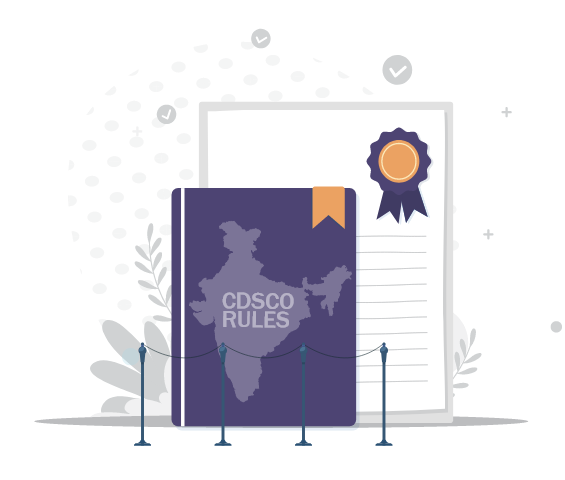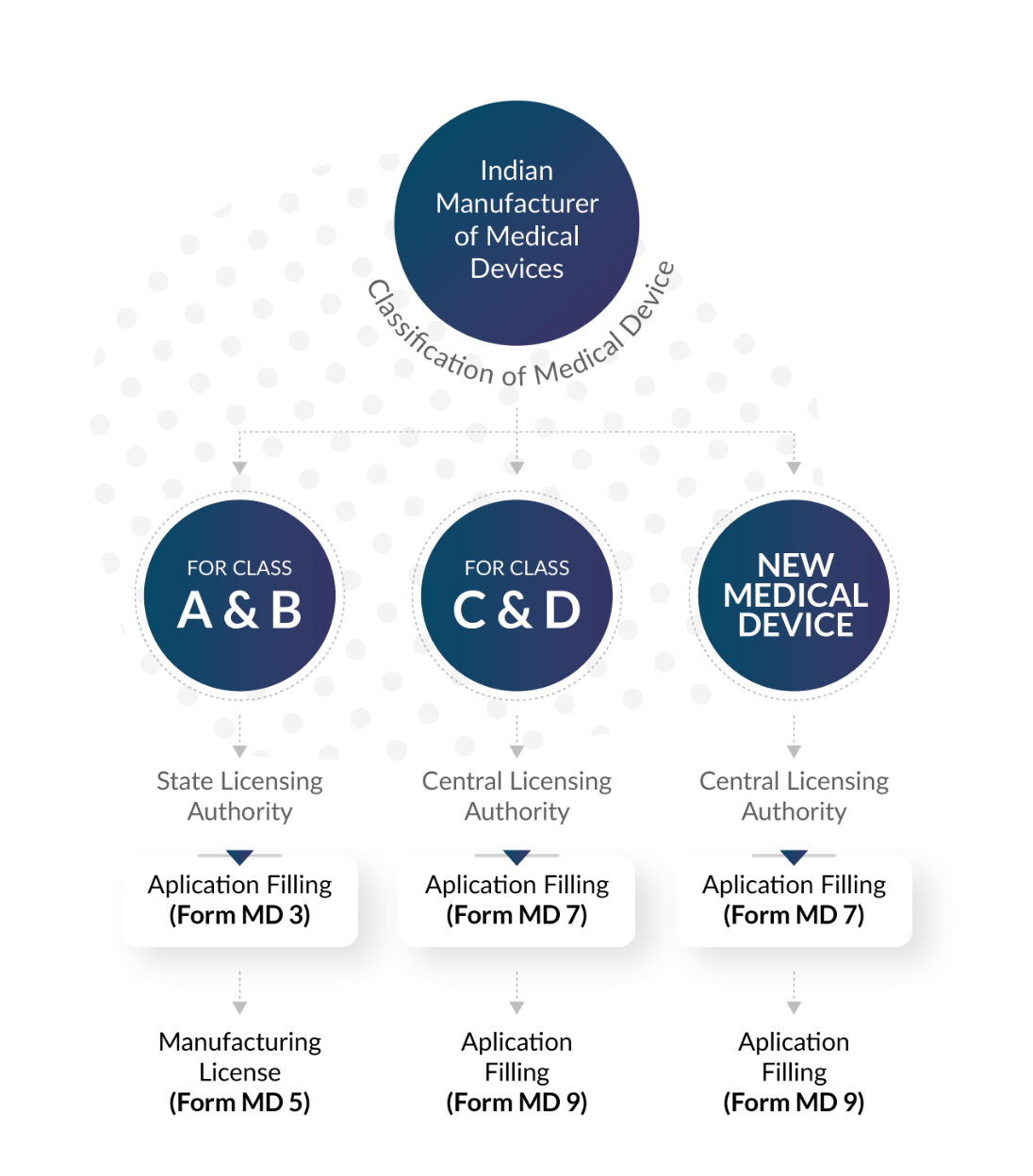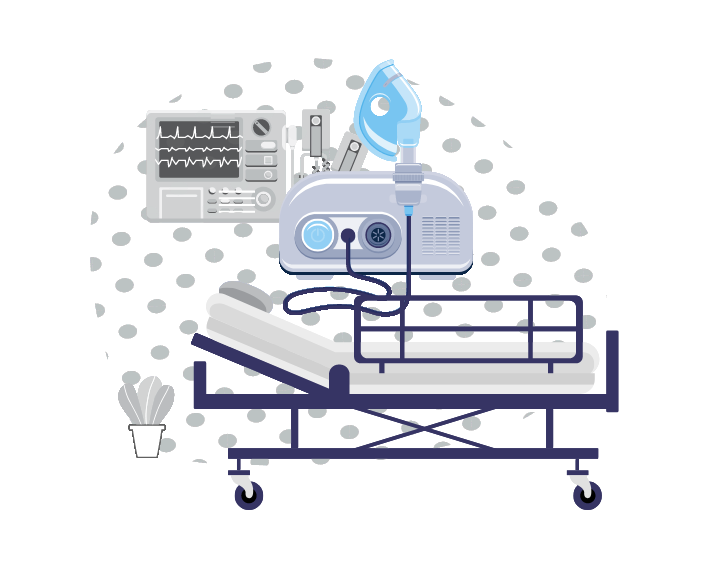CDSCO
Regulatory Services for Manufacturers
CliniExperts served 125+ medical device manufacturers so far. We manage all regulatory and compliance mandates seamlessly
Medical device manufacturers, when it comes to fulfilling your regulatory mandates, CliniExperts enjoys a proven leadership status. With a roster of 125+ clients that includes reputed names of the medical device industry, we are often referred to as the obvious choice for regulatory partnership. Why? Because we bring ethics and integrity along with experience and efficiency. We have a zero-defect record in terms of filings for licenses, approvals, certifications, etc. And rather than cutting corners, we go the extra mile to offer clients a delightful experience of our full-stack services. Add to this our end-to-end engagement, and what you get is a preferred regulatory partner.
CDSCO – How it governs Medical Devices regulatory affairs
In India, the Central Drugs Standard Control Organisation or CDSCO, manned by the Directorate General of Health Services under the aegis of the Ministry of Health and Family Welfare, governs the regulatory ecosystem for medical devices.
Strict procedures must be followed in accordance with the norms and guidelines established by the Central Drug Standard Control Organization while manufacturing Medical Devices (CDSCO).
CliniExperts has the experience and expertise to fulfil the entire regulatory process with a zero-defect capability.



ABOUT CLASS A, B, C and D Medical Devices
As per the New Medical Rules, 2017, all medical devices have been classified into four distinct classes. According to the MDR, the categories are Class A, Class B and Class C, and Class D. This the range of medical devices governed by CDSCO:
- Cardiac Stents
- Drug Eluting Stents
- Catheters
- Intra Ocular Lenses
- I.V. Cannulas
- Bone Cements
- Heart Valves
- Scalp Vein Set
- Orthopedic Implants
- Internal Prosthetic replacements
For easy identification, CDSCO has classified these devices into four categories:
- Class A: Low risk – Alcohol swabs.
- Class B: Low moderate risk – Thermometer, BP measuring devices, disinfectants, etc.
- Class C: Moderate high risk – Implants, hemodialysis catheter, etc.
- Class D: High risk – Heart valve, angiographic guide, etc.

Class A and B Medical Devices
A medical device is a product used for human or animal diagnosis, treatment or prevention of diseases. According to the Medical Devices Rules, 2017, medical devices are classified into four categories- Class A to Class D based on their risk. Class A and Class B medical devices come under the category of low-to-moderate risk.
Class A medical devices are low-risk devices with minimal or no invasiveness (like thermometers) Class B medical devices are low-to-moderate risk devices with minimal invasiveness (like needles and suction cannula).
Class C and D Medical Devices
According to the Medical Devices Rules, 2017, medical devices are classified into four categories- Class A to Class D based on their risk. Class C and Class D medical Devices are classified as Moderate high risk and High risk. The application to manufacture these medical devices is required to be made at the Central Licensing Authority.
New Medical Devices
All devices consisting of an instrument, apparatus, implant, or another article, doesn’t matter used alone or in combination, containing software or an accessory, designed by the manufacturer for intended use on human beings or animals by any pharmacological or immunological, but it may help in its expected functions including diagnosis, prevention, monitoring, treatment, replacement or alleviation of any disease or disorder, injury or disability, and control of conception.
Why Choose CliniExperts?
Invest in Trusted Excellence of CliniExperts to unleash the Potential of Indian Medical Device Manufacturing.
Contact our team to get the best support for regulatory services in India

Existing Devices
| Applicant | Risk/Class | Type of Licence | Forms |
| Importer | A,B,C,D | Importer Licence | Application: MD-14, Application: MD-15 |
| Manufacturer | A,B | Manufacturing Licence | Application: MD-3, Application: MD-5 |
| Loan Licence | Application: MD-4, Application: MD-6 | ||
| C,D | Manufacturing Licence | Application: MD-7, Application: MD-9 | |
| Loan Licence | Application: MD-8, Application: MD-10 |
New Devices
| Applicant | Risk/Class | Type of Licence | Forms |
| Importer | A,B,C&D | Clinical Investigation Permission | Application: MD-22, Application: MD-23 |
| A,B,C&D | Import Licence | Application: MD-26, Application: MD-27 | |
| A,B,C&D | Test Licence | Application: MD-16, Application: MD-17 | |
| Manufacturer | A,B,C&D | Clinical Investigation Permission | Application: MD-22, Application: MD-23 |
| A,B,C&D | Manufacturing Licence | Application: MD-26, Application: MD-27 | |
| A,B,C&D | Test Licence | Application: MD-16, Application: MD-17 |
How It Is Regulated?
This is the regulatory process flowchart for medical device manufacturing in India:
- Application in Form 27 to be submitted to the state licensing authority
- Application must include these details:
-
- Complete details of the manufacturing facility and infrastructure, along with the details of company and its owners/directors and senior technical personnel
- Project report
- Site master file
- Details of manufacturing process
- Details of good manufacturing practices to be followed by the manufacturer
- Copies of ISO and other certifications if possessed by the applicant
- Complete product details including the category of device, specifications, brand name, and other such details
- An expert committee evaluates the application and forwards its observations/recommendations to the state level authority
- This committee conducts joint inspection of the manufacturer’s facility and infrastructure
- On satisfactory conclusion of the inspection, this committee sends the papers to the Central licensing Approval Authority (CLAA) to grant manufacturing permission
- License is issued in From 28 by CLAA

Why to get manufacturing License before 1st October, 2022
In pursuance of notification No. G.S.R. 102(E) dated 11.02.2020, all non-notified medical devices of Class A & Class B categories are scheduled to enter licensing regime with effect from 01.10.2022 A transition period of 30 months had been provided for Class A & Class B medical devices from the date of implementation of G.S.R. 102(E) i.e. 01.04.2020 for the transition to the licensing regime.
So now it is advised that all manufacturers shall apply for obtaining a manufacturing license for Class A & Class B medical devices through COSCO`s online portal so that the manufacturing license can be granted by respective State Licensing Authorities after review of the applications and audit (as the case may be) as per the stipulated time.

CliniExperts Can Assist In
Primarily, clients prefer us for four reasons:
Steadily growing client roster and 100% retention rate. When looking for a regulatory partner, market stature and size are the first check-points, and CliniExperts wins this round hands-on.
Ethics, integrity, and excellence. We are a responsible and respectable name that is also pragmatic, and possesses resources to deal with the regulatory dynamics and ground realities.
Talent and commitment. CliniExperts teams across functions are led by the industry’s front-benchers, with an unquestionable commitment to quality.
Always-up-to-date. We pride in our cutting-edge knowledge and information pool, which helps us file perfectly compliant applications complete in every respect.
The sum of these features often awards us the “most favoured service provider” status.
Let’s join hands to form a long-lasting, mutually rewarding and respectable association!
Form Names: MD3, MD5
Permission to Manufacture Class A-B Medical Devices
The licensing authority in India is the Central Standard Control Organisation (CDSCO). The licensing process in a nutshell: Fill up the exhaustive application Form MD-3 and upload it on the SUGAM portal State licensing authorities issue permission to manufacture Class A and B devices on Form MD-5 after a grueling evaluation process
Regulatory Body Requirement
Manufacturing medical devices requires stringent processes to be completed under the laid down rules and regulations by Central Drug Standard Control Organisation (CDSCO). In addition, applicants who intend to manufacture Class A or Class B medical devices have to go through a procedure by applying for a license to sell or distribute medical devices. The CDSCO ensures quality and safety of medical devices sold in the market in this manner.
Such applicants have to apply to the State Licensing Authority for approval from the Ministry of Health and Family Welfare's online portal, depending on the applicant's location. An application has to be submitted in FORM MD-3 along with necessary documents for procuring a license as FORM MD-5.
How to Apply
A manufacturer should apply via the FORM MD-3 to the State Licensing Authority for manufacturing, sales or distribution of medical devices. A list of documents is required to be submitted along with the FORM MD-3, including;
- Step 1: Collect a list of essential documents like Cover letter, Location ownership/ agreement/ tenancy, details of constitution of the firm, test license, IVD`s, quality control data
- Step 2: Apply and submit through Form MD-3 to the State Licensing Authority for manufacturing, sales, or distribution of Medical Devices.
- Step 3: Wait for the review process of the submitted documents and Forms
- Step 4: Allow an inspection of the manufacturing site conducted for Class B Medical Devices
- Step 5: After the review, the State Licensing Authority will grant the manufacturer permission and the manufacturing license in Form MD-5
Form Names: MD4, MD6
Permission for Loan License to Manufacture Class A - B Medical Devices
Financial constraints can prevent you from achieving the success that your business deserves. A loan for manufacturing new notified medical devices of Class A and Class B, or for increasing the scale of production of your existing notified medical devices can help you soar to new heights. Contact CliniExperts today to help you sail through the paperwork and obtain the Loan License for Manufacturing of Class A and Class B notified medical devices via Form MD – 4 and Form MD – 6 in no time!
Regulatory Body Requirement
Any company which intends to obtain a loan license to manufacture Class A and/or B medical devices needs to make an application as per provisions of Medical Devices Rules, 2017. Medical devices classified as Class A and Class B are considered low and low-to-moderate risk devices, and they may also include in vitro diagnostic devices.
The manufacturer who wants to receive a grant for a Loan License for further sale and distribution of class A and B medical devices needs to file an online application through the online portal of the Ministry of Health and Family Welfare in the Central Government via the State licensing Authority. The application can be filled in Form MD-4 for Grant of Loan License to Manufacture for Sale or for Distribution of Class A or Class B medical device.
How to Apply
- Step 1: Sugam Registration of the applicant
- Step 2: Drafting of Application
- Step 3: Upload of document as per checklist of MD-4
- Step 4: Processing of the Requisite Govt Fee
- Step 5: Submission of Application on Online medical device portal
Form Names: N/A
Medical Device ISO 13485 Certification Assistance
From design, to R&D, testing, manufacturing, sales and distribution, storage, and end-usage – Medical device lifecycles are increasingly controlled by regulatory and compliance mandates. ISO-13485 is designed to ensure the safety, effectiveness, and accuracy of these devices at the user end. Hence, being ISO-13485 certified is critical for all stakeholders – Be it the designers, manufacturers, suppliers, service providers, or distributors.
CliniExperts has long-standing experience to undertake end-to-end fulfilment of ISO-13485 process. Our in-house experts, in collaboration with the registered process facilitators and auditors, offer best-in-class services for a smooth and hassle-free ISO-13485 certification.
Regulatory Body Requirement
ISO 13485 Certification provides a comprehensive framework for medical device designers, manufacturers, suppliers, service providers, and distributors to assure quality, safety, and regulatory compliance. ISO 13485 is a distinctive QMS (Quality Management System) standard evolved from the globally recognized standard - ISO 9000.
ISO 13485 Certification implies that a company has met all the requirements and has effectively implemented an ISO 13485 QMS focusing on the efficacy and safety of medical devices. The certification follows the PDCA framework wherein the applicant must establish and implement quality management in accordance with the ISO 13485 standard. Following the implementation of the QMS, the applicant needs to approach an accredited notified body for the audit of the organization. The accredited notified body performs an audit to assure that the firm can continuously meet and sustain quality standards and issue the certification.
Usually, it takes around 6-9 months to complete the ISO certification process.
How to Apply
- Define the scope of the ISO 13485 Certificate Initially, it is necessary to envision the objectives of your organization and the scope for the certification.
- Select notified body
- Establish QMS and prepare necessary documents.
- Implement the PDCA cycle and work in accordance with your QMS.
- Prepare and optimize audit
- Conduct Internal and pre-assessment audit
- Proceed for a certification audit by a notified body. The notified body will audit your company for two to ten (or even more) days depending on the size of your organization. Finally, the notified body will issue the certificate(s) if the organization passes the audit successfully.
Form Names: MD-22, 23
Conduct clinical investigation
The objective of clinical investigation of medical products is to collect information to assess the quality and safety of medical products concerning their intended purposes. This is done to determine the possibility of adverse consequences or dangers associated with the product. Similar to the approval process for medications, the clinical study of the medical device is crucial to use either on or by humans to test and evaluate the effectiveness, performance, and security of medical devices.
Regulatory Body Requirement
The manufacturers and importers who wish to carry out a clinical investigation of an investigational medical device should obtain permission from the CLA, which can be done through an online application process.
How to Apply
The manufacturer or importer who intends to conduct a clinical investigation of medical devices can apply via the following procedure:
- The application for grant of permission to conduct a clinical investigation of an investigational Medical Device can be made in Form MD-22
- The application should address the Central Licensing Authority of India and the Central Drugs Standard and Control Organisation.
- The application should be submitted with the required documents and the application fees on the SUGAM portal.
Form Names: MD-26, 27
New Medical Device permission
To get an import/manufacturing license for the sale/distribution of a medical device that does not have a predicate medical device, the Importer/Manufacturer must make an application to the Central Licensing Authority. The Import license applicant must do this via an authorized agent having a manufacturing or wholesale license for the sale or distribution of medical devices. The application should be made to the Central Licensing Authority via an online portal of the Ministry of Health and Family Welfare in the Central Government using Form MD-26 and the permission is received in the Form MD-27.
It is the responsibility of an experienced professional to fulfil these standards. Attempts made internally frequently waste time, money, and resources. The regulatory professionals at CliniExperts can manage it with ease.
Regulatory Body Requirement
As per the provisions of Medical Device Rules, 2017, notified medical devices which need to be imported/manufactured in India, which does not have a predicate medical device, will be required to make an application using FORM MD-26. FORM MD-26 is necessary to grant permission for importing/manufacturing these medical devices. Central Drugs Standard Control Organization (CDSCO) is the regulatory authority of India that grants the permission to import or manufacture new medical device in India- Form MD 26 & 27
How to Apply
- STEP 1: Evaluation of the product, if it requires registrations as per MDR 2017
- STEP 2: If requires registration, Evaluation of classification (Class A…….)based on the product risk category
- STEP 3: Preparation of documents as per the MD 26 checklist
- STEP 4: Appoint Authorized agent in case of Import of the product
- STEP 5: Online generation of application
- STEP 6: Before submission of application, approval/confirmation of draft application by the authorize agent/manufacturer
- STEP 7: Follow-up with regulatory authority
Form Names: MD7, MD9
Permission to Manufacture Class C-D Medical Devices
The Central Drugs Standard Control Organization is the top Indian regulator that supervises the manufacture and distribution of accepted medical equipment (CDCSO). In India, the regulatory authority is responsible for granting licenses and approving the manufacturing and use of medical equipment. FORM MD-7, along with FORM MD-9, are utilized by this agency to issue manufacturing permits in accordance with the Medical Device Rules of 2017.
Regulatory Body Requirement
The highest Indian regulatory body supervising the manufacturing of notified medical devices is the Central Drugs Standard Control Organisation (CDCSO). In India, the regulatory authority is responsible for giving license and approval for the manufacturing of medical devices. This regulatory authority provides the manufacturing licenses in Form MD-9 which is required as per the provision of Medical Device Rules, 2017.
An application needs to be submitted to the Central Licensing Authority for a manufacturer license. This can be applied through the online portal of the Central Government. A manufacturer license allows the sale or distribution of Class C and Class D medical devices in Form MD-9 which is obtained by applying via Form MD-7.
How to Apply
A manufacturer must apply for a Grant of License to manufacture for Sale and distribution Class C or Class D medical devices
- Step 1: Application can be made to the Central Licensing Authority in Form MD-7
- Step 2: The application requires the following documents:
- Cover letter, plant master file and device master file
- Quality Management System specified as per the 5th schedule of Medical Device Rules and performance evaluation report (IVDs only)
- Constitution detail of the firm, the establishment/site ownership/tenancy Agreement
- Valid Test License obtained for testing and generation of quality control data
- Singed undertaking stating that the manufacturing site is following provisions of the Fifth schedule.
The application is reviewed by the CDSCO. An inspection of the manufacturing site might be conducted by a Notified body or by Medical Device Officers, with or without an expert. Basis this, the CDSCO may decide to issue the valid license in Form MD-9.
Form Names: MD4, MD6
Permission for Loan License to Manufacture Class C - D Medical Devices
Financial constraints can prevent you from achieving the success that your business deserves. A loan for manufacturing new notified medical devices of Class C and Class D, or for increasing the scale of production of your existing notified medical devices can help you soar to new heights. Contact CliniExperts today to help you sail through the paperwork and obtain the Loan License for Manufacturing of Class C and Class D notified medical devices via Form MD – 8 and Form MD – 10 in no time!
Regulatory Body Requirement
According to the Medical Devices Rules, 2017, a loan manufacturing license in Form MD-10 is required for loan manufacturing of Class C & D (Notified) medical devices in India. These loan license applications are filed in Form MD-8, which is used to obtain the licenses in Form MD-10.
In order to obtain a loan license to manufacture Class C & Class D medical devices, the manufacturer has to make an application to the Central Licensing Authority via an online portal of the Central Government. It takes between 4-5 months to complete the process.
How to Apply
- Step 1: Sugam Registration of the applicant
- Step 2: Drafting the Application
- Step 3: Uploading all the documents according to checklist of the form MD-8
- Step 4: Processing of the mandatory government fee
- Step 5: Submitting the application on online Medical Device portal
Form Names: N/A
SUGAM Registration- MD/ IVD
Under the ambitious Digital India initiative, the Ministry of Health and Family Welfare has established the versatile and efficient SUGAM portal. With its 3600 tracking, querying, upload/download, and many other useful features, the SUGAM interface facilitates digital processing of almost all requirements related with Class A and B medical devices. Cliniexperts’ thorough knowledge of this portal can speed up these processes in a ZERO-ERROR digital environment.
Regulatory Body Requirement
The registration process for medical devices is primarily done on the SUGAM portal, a website where the applicants apply for approval of licenses, FSC and Registration numbers. In addition, the portal provides an interface and ease of access for applicants to track the submitted application, query responses and the ability to download permissions issued by the CDSCO.
Any applications submitted are reviewed and approved/rejected by the CDSCO. The process involves the submission of necessary documents on the online portal. After uploading the documents, applicants must submit a hard copy of the papers to the CDSCO (Medical Device Division) for further approval on the medical device portal.
How to Apply
- Step 1: An applicant (manufacturer/importer) requires a user login id with the credential to apply on the SUGAM portal (https://cdscomdonline.gov.in/NewMedDev/Homepage).
- Step 2: The registration requires uploading all the self-attested copies of the undertaking (the documents which include the name and address of the Company and issued by the Government Authority).
- Step 3: The applicant also has to upload Aadhar ID proof (Authorised person/agent), the manufacturing license or Wholesale Drug License and the certificate of incorporation.
- Step 4: After online registration, the applicant must submit hard copies of all the uploaded documents and the Cover Letter to the CDSCO for verification. The CDSCO will approve the Sugam Registration after evaluating the proposed application and the documents.
Form Names: MD12, MD13
Test license to Manufacture Medical Devices (Form MD 12, 13)
Medical Devices must establish a stringent product testing regime. Apart from a vast range of testing parameters including testing on different software, this regime also includes a strict compliance protocol. Once test licence is obtained permission for manufacturing is required.
Once all these parameters are established, an application to procure a test license has to be submitted on Form MD-12, and the permission is granted on Form MD-13.
Fulfilment of these requirements is an experienced expert’s task. In-house attempts often result in waste of time, money, and resources. CliniExperts, the regulatory experts, can handle it effortlessly.
Regulatory Body Requirement
In India, small quantities of Class A, Class B, Class C, or Class D medical devices may be manufactured by procuring a Test License in Form MD-13 issued by CDSCO. These devices can be used for the purpose of clinical research, testing, evaluation, demonstration, or training.
A person who intends to manufacture a medical device must apply for a Test license by filling out a Form MD-12 from an identified online portal of the Ministry of Health and Family Welfare for the purpose of test, evaluation, demonstration, and training. The Ministry of Health and Family Welfare will then issue a Test license in the Form MD-13.
How to Apply
The application is done with reference to MDR 2017. Registration on the Sugam portal is mandatory for applying for the test license
- Step 1: Register the applicant on Sugam portal
- Step 2: Draft application
- Step 3: Upload mandatory documents as per check list of MD-12
- Step 4: Payment of Requisite government fee
- Step 5: Submit the application on online medical device portal
Contact us
Please feel free to talk to us if you have any questions. We endeavour to answer within 24 hours.

